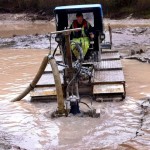 Over time the build-up of silt in any body of water will cause some serious issues and with autumn approaching it’s time to think about an essential element of maintenance – silt removal – if you want to avoid:
Over time the build-up of silt in any body of water will cause some serious issues and with autumn approaching it’s time to think about an essential element of maintenance – silt removal – if you want to avoid:
• Increased risk of flooding
• Loss of fish and wildlife
• Restriction or loss of use as a recreational facility
• Bad odour and dense algae blooms
Silt in any waterway is produced by run-off from the surrounding ground, inlets from streams or rivers, and decaying organic matter, including leaves, dead aquatic plants and weeds and fish waste.
Whether the body of water is used for recreational hobbies (boating, fishing, swimming, etc.) or is just an attractive focal point, over time excessive silt accumulation will cause dramatic deterioration to the quality of water, and its function and beauty.
Increased risk of flooding
As silt accumulates, the overall capacity of a lake or pond decreases. If there is an outlet that is also blocked with silt, heavy rains will cause flooding on the adjacent land, which is particularly disastrous if there is property on that land, if it is agricultural, or if it’s in use for leisure or commercial activity, e.g. a golf course, public park etc.
Loss of fish and wildlife
If there are large quantities of semi-decomposed leaf and plant debris, oxygen levels in the water will be reduced, which is detrimental to fish and other aquatic life present. It also often creates acidic conditions, which further reduce the quality of the water.
Waters that have become very shallow due to silt build-up also pose a threat to fish stocks too – they need deeper, cooler water in warm weather, and they are more prone to fish kills from predators.
The shallower a body of water becomes, the more it will impede the use of sailing or motor boats risking damage to hulls and propellers. It will also get warmer during the summer, resulting in increased algae and weed growth.
Restriction or loss of use as a recreational facility
Lakes, rivers and canals used for leisure activities are also at risk from heavy silt deposits. Leisure boats, whether sailing or motor boats will eventually be unable to navigate waterways that have become too shallow, and risk being damaged.
Silt and sediment will eventually block any inlet and outlet on a lake or pond and the lack of moving water will cause stagnation and further deplete oxygen levels – again not good news if you’re a fish!
Bad odour and dense algae blooms
Even if the body of water you are responsible for is an attractive focal point in the landscape of a private public garden, it is not beyond the negative impact of too much silt!
Blocked inlets and outlets will prevent water flow, giving rise to the possibility of stagnant water which smells and looks extremely unpleasant, and the high nutrient levels of the silt encourage dense algae blooms, spoiling the water quality and aesthetics.
Solving the problem
Using their amphibious Truxor DM5000 machines, with clamshell and pump attachments the Aquatic Solutions team can dig or pump out the silt from any body of water, to a depth of 2.4 metres. The machines work from the surface of the water, which means there is no risk of sinking into the silt, as heavy excavators would.
The small and lightweight vehicle leaves no more of an imprint than a human footprint, so has minimal impact on the land surrounding the body of water, making it ideal for use in sensitive areas, such as golf courses, private gardens, or SSSIs and nature reserves. Minimal restorative work is required once work is completed.
We ensure that fish stocks are well looked after, by first clearing any inlet so the fish can go to the fresh water area. The action of the Truxor paddles also help to oxygenate the water, reducing the impact of disturbance on the fish as the work is carried out.
Recycling the removed silt
Removing the silt from site is the most expensive and environmentally unfriendly option. We have a number of solutions to avoid this:
- De-watering bags are filled with the removed silt, and left for the water to drain out back into the lake, pond, canal etc. Once dried, the bags can be opened and the nutrient rich silt can be used for landscaping elsewhere on site.
- We can install a Nicospan permeable membrane fence around the water’s edge to create a new bank. The silt can then be either pumped or deposited behind the membrane, which allows water through but retains the silt. When the silt has begun drying out it can be planted with marginal plants, giving an attractive new border to the water’s edge, which will also prevent future bank erosion.
- Re-distribute the silt – spread thinly over the surrounding land, (subject to Environment Agency guidelines) it will allow the existing vegetation to grow through.
When we have completed the job you will be assured that:
• The body of water has regained lost storage capacity – reducing the flood risk
• A healthy habitat for fish and other aquatic animals has been restored
• The water is once again fit for use for recreational activities.
Aquatic Solutions offer:
• Fully trained and qualified staff
• Efficient and cost effective silt removal solutions
• Care and attention to detail
• Free telephone consultations
• Free quotations
Do you think you have a problem with excessive silt and would like to know more about how it could be tackled?
Here are is a video of the Truxor silt pumping at The Eden Project, and a case study detailing the work carried out.
If you would like further information on silt removal feel free to email us with details of your particular problem, and your site address – we use Google Earth to carry out a “virtual” survey of the site.
If you prefer, call us for an informal discussion on 01788 810614, or use the contact form below:
Error: Contact form not found.
